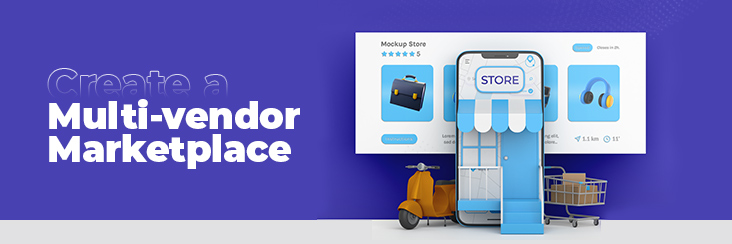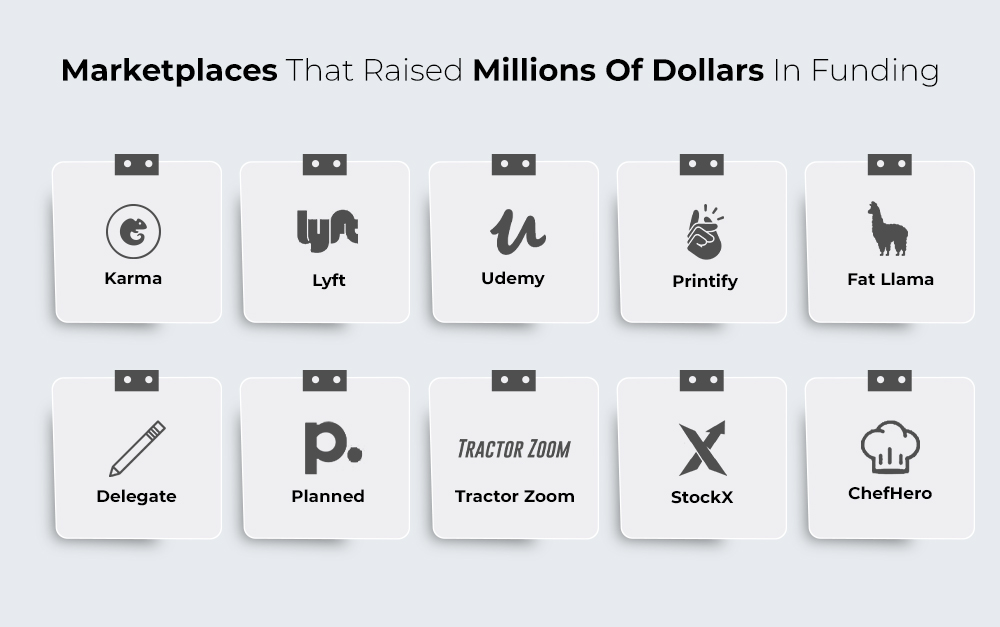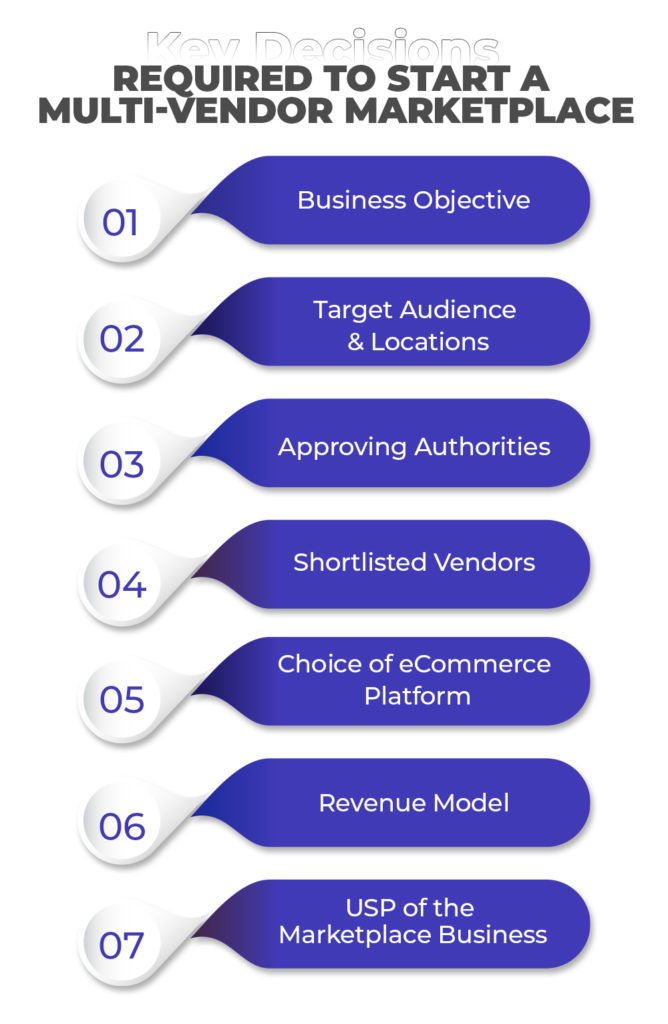

How To Build A Multi-Vendor Marketplace Website?

Running short of time? Get PDF of the blog in your mail.
|
Play Now

|
Online marketplaces are fulfilling the changing needs of buyers as well as sellers. To build a multi-vendor marketplace, you need to first understand how these are redefining the way people shop online. Amazon, eBay, AliExpress, and Walmart are among the top players that make the highest online sales globally. This blog talks about all the details with which you can create a marketplace with Magento.
What Is A Multi-Vendor Marketplace?
An online marketplace is an extensive eCommerce platform that offers products and services from more than one seller. It consists of all the functionalities that complete the buyer’s journey, such as – product discovery, online ordering, shipping and payments, review and ratings, etc.
To build a marketplace, all the above functionalities will be added to the online store. It is a one-stop destination where one can find different products from vendors, shops, or individuals showcased on the same platform. With the advancement of technologies and the emergence of new software, the cost to build a multi-vendor marketplace is also lowered.
The marketplace owner will create a website and is responsible for attracting customers and processing transactions. The third-party vendors only deal with keeping their products updated and in stock.
Demand for online marketplaces
As per a survey, a vast majority (83%) of power shoppers in the U.S. find marketplaces most convenient for online purchases. With 10.4% of all retail sales predicted to be made online in 2023, the demand for marketplace popularity is expected to rise.
It is now a globally accepted fact that the overall experience on a marketplace is far superior to an individual website. This is also evident by the fact that marketplaces contribute 47% of all the digital purchases worldwide. Further on this, the revenue from marketplace platforms more than doubled from 2017 to 2022.
Types of marketplace platforms
-
- B2B Marketplace: It is the fastest growing industry when it comes to multi-vendor models. A business-to-business marketplace is one where product and service transactions only happen between businesses, for example, Alibaba.
- B2C Marketplace: A Business-to-Consumer marketplace is a platform for retail transactions directly with consumers. They concentrate on pitching to people and marketing their items for individual consumption; for example, Starbucks.
- B2B2C Marketplace: As the name suggests, these cater to both B2B and B2C transactions. Furthermore, consumers or even other businesses can make purchases from the online store of a business entity. Amazon is a great B2B2C multi-vendor marketplace example.
- C2C Marketplace: It is a type of marketplace in which product and service transactions happen between customers. The main focus of this marketplace is to build a healthy relationship between buyer and seller to find each other, for example, eBay.
- P2P Marketplace: The peer-to-peer marketplace brings together users who offer products and services offline. In this, the buyer and seller directly communicate with each other, for example, Etsy.
Read this innovative story of ExpressGrass marketplace based out of the US and UK to get your inspiration.
Types of revenue models in a marketplace
The owner of the marketplace has multiple methods of income from this platform. It can be rightly said that building a marketplace platform means higher returns and accelerated growth. Some of the revenue streams are:
- Commission fee: The marketplace owner can charge a commission fee on every transaction of the vendor listed on its platform. This can be in the form of a flat rate or a percentage share of the transaction amount.
- Listing fee: Multi-vendor eCommerce websites for sales and exchanges typically have a fee for their vendors, known as a posting or listing charge. The listing charge is generally based on the value of the products and the number of days it is to be displayed. A real-life multi-vendor marketplace example of this is Etsy. It charges a fee for listing your product.
- Account fee: Some multi-vendor eCommerce websites charge this fee for registering and opening your account on their website for selling products. For example, Sears charges $39.99 to open an account.
- Fulfillment Center fee: It is the fee that is paid for the products which are in the warehouse for shipping. This fee is paid for spacing your product takes in the warehouse. Every eCommerce marketplace charges this fee.

A well-researched and designed multi-vendor model can easily receive funding from external sources.
Benefits of multi-vendor marketplaces
Build a marketplace, and it will, by default, offer a plethora of benefits for all of its stakeholders. To simplify this further, we have listed below some of these with a focus on all groups.
For store owner
It is a wise decision for entrepreneurs to create a marketplace with Magento in place of a single-seller store. This is so because of the numerous advantages that come along with these platforms, including the cost to build a multi-vendor marketplace is relatively low. Let us look at some more:
- Low investment, high return business model
- Diversified stream of income with lower financial risk
- Transparent supply chain with streamlined processes
- Improved customer experience with more variety
For sellers
Marketplace platforms are very convenient for sellers, especially the smaller ones, who do not have any digital presence yet. Some benefits include:
- Easy to add new markets and test a new market
- Limited investment to access a wider audience
- Efficient way to expand business and sell across borders
- Reduced overhead expenses on maintenance and technology
For buyers
Buyers form the key consumers of marketplace platforms. Marketplaces provide them with multiple options at every stage to choose from. Let’s look at some of these benefits:
- Access a wide range of product varieties from different sellers
- Multiple and flexible choices to make payments
- Easy to make comparisons between available options
- Standardized and reliable processes for returns and refunds
Approach to building a marketplace
Wondering how to build a multi-vendor marketplace? The most important aspect lies in deciding its functionalities more so because it is a platform where multiple users will experience and access what your business has to offer them.
For the consumers, it needs to help them discover, choose, purchase and return. For the sellers adding and selling products should be a smooth ride. And lastly, build a marketplace that keeps the store owner at the top of all these actions and more.
Must-have capabilities
- Admin controls – to manage all the user activities on the platform, track and measure the business performance through individual contributions
- Insightful reports – to precisely connect with the consumers and fill in any gaps that can further improve engagement and revenue
- Ease of experience – for its users, i.e. vendors and consumers, to navigate the platform smoothly and perform their respective actions
- Smooth checkout – a single-page checkout helps to avoid any last-minute friction that is the final deciding factor for a successful conversion to happen
- Mobile optimized – for uninterrupted access to all the products and services on smartphones
- Vendor actions – that allow the vendor to manage its account and orders in the best possible ways
- Flexible payment methods – for providing convenience to consumers with different credit options
- Shipping solutions – to help orders reach the right person at the right time worldwide

7 steps to create a fully-functional marketplace
Check out our step-by-step approach to building a marketplace. Follow the right sequence to avoid any complications and set up a fully featured website for your business.
- Identify the product niche and define exactly what products or services your business would offer. For example, luxury accessories, electronics marketplace, grocery supplies, or any other niche that you shortlist based on your market research
- After the product niche, understand who your audience is. This should ideally include the age group, location, designations and other details that help you connect more closely with the target groups.
- Now to proceed further, you need to specify whether your business should be based on a B2B, B2C, B2B2C or any other multi-vendor model depending on the target groups and the product niche. Along with this also define the revenue strategy here at this step.
- Now comes the development-related part. So choose a domain name, hosting, a multi-vendor platform and the solution that goes with it. All of these are the basic requirements that will ease the development process and ensure all your basics are sorted.
- Once the platform is selected, make the choice of configurations that align with your business objectives. In case you need any additional functionality then choose the appropriate extension or add-on based on your solution partner’s suggestion.
- Test run the site that has been set up and check how it is performing before you launch it for your audience.
- The final stage is here. It’s time to make your marketplace app go live! Launch and begin the promotions that can make your launch a success.
Different methods to build a marketplace
There are various methods to create a marketplace with Magento. Specific business requirements can help to choose the ideal one. While some businesses prefer to build the entire storefront from scratch, others need a faster closure on this.
Below are the ways to build a multi-vendor eCommerce website:
-
Use marketplace extensions:
Single-seller stores can be easily converted to marketplace websites by using extensions. These help to add all the features needed for adding vendors to your existing website. This method takes lesser development time while providing exceptional features for vendor management.
-
Build a marketplace from scratch:
This method is more accurate for bigger businesses that are focused more on maintaining their brand values and getting their exact expectation built on their online stores. Though the development will take longer than the earlier method, the output will be far more customized. This may also mean more dedicated maintenance and support on an ongoing basis.
-
Choose a pre-built marketplace solution:
Plug-and-play solutions are also available for different industries that are designed to achieve excellent support for adding vendors. Industry-based businesses can choose from different available solutions.
Before we dive into the marketplace solutions from CedCommerce, click on the link below to explore the enterprise marketplace guide. The guide is your all-in-one resource to learn the benefits, key challenges, strategic direction for a successful launch, must-have features of an enterprise marketplace, and more.
CedCommerce marketplace solution
CedCommerce offers an extensive range of features for merchants and businesses to deploy the most advanced level of marketplace websites and mobile apps. The most popular and widely accepted solutions are the marketplace extensions that have helped thousands of businesses grow into a marketplace. These are further available in two versions:
Marketplace Platinum Package:
Designed for mid to large-sized businesses, some of the most liked features of this package are:
- Unlimited products and vendors
- Simple, downloadable, virtual, configurable, bundled, grouped product types
- Order management for vendors and admin
- Different types of commissions for admin
- Social logins for vendors and customers
Find a complete list of features with details about the Marketplace Platinum Package by CedCommerce here.
Marketplace Advance Package:
It is a superior solution suitable for big-sized businesses focused on getting advanced-level controls on their marketplace websites. It includes all the features of the above package and:
- Support tickets for the resolution of client queries
- Bulk Import/Export options for vendors
- Price comparison from different vendors
- Split payments methods
- Return options for products
- SMS notifications for vendor activities
Find a complete list of features with details about the Marketplace Advance Package by CedCommerce here.
Conclusion
As we all know, building a marketplace is not easy, but with the right planning and execution of that plan, you can achieve great heights in that field. CedCommerce provides you with support to help you build multi-vendor marketplace solutions. If you want to make your dream come true, we provide you with a marketplace open-source script with non-encryption. You can also easily customize all features and products.
Learn more about creating an online marketplace from CedCommerce experts
